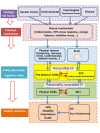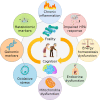Understanding the Physiological Links Between Physical Frailty and Cognitive Decline
- PMID: 32257550
- PMCID: PMC7069469
- DOI: 10.14336/AD.2019.0521
Understanding the Physiological Links Between Physical Frailty and Cognitive Decline
Abstract
Declines in both physical and cognitive function are associated with increasing age. Understanding the physiological link between physical frailty and cognitive decline may allow us to develop interventions that prevent and treat both conditions. Although there is significant epidemiological evidence linking physical frailty to cognitive decline, a complete understanding of the underpinning biological basis of the two disorders remains fragmented. This narrative review discusses insights into the potential roles of chronic inflammation, impaired hypothalamic-pituitary axis stress response, imbalanced energy metabolism, mitochondrial dysfunction, oxidative stress, and neuroendocrine dysfunction linking physical frailty with cognitive decline. We highlight the importance of easier identification of strategic approaches delaying the progression and onset of physical frailty and cognitive decline as well as preventing disability in the older population.
Keywords: biology; cognitive decline; cognitive frailty; physical frailty.
Copyright: © 2020 Ma et al.
Conflict of interest statement
Competing and conflicts of interest None of the authors have any conflicts or competing interests in the article.
Figures


References
-
- Dent E, Dent E, Lien C, Lim WS, Wong WC, Wong CH, Ng TP, et al. (2017). The Asia-Pacific Clinical Practice Guidelines for the Management of Frailty. J Am Med Dir Assoc, 18(7):564-575. - PubMed
-
- Ma L, Tang Z, Zhang L, Sun F, Li Y, Chan P (2018). Prevalence of Frailty and Associated Factors in the Community-Dwelling Population of China. J Am Geriatr Soc, 66(3):559-564. - PubMed
Publication types
LinkOut - more resources
Full Text Sources
